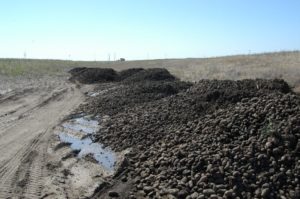Jul 27, 2022Researcher’s model finding warmer temps favoring more volunteer spuds
A University of Idaho (U of I) researcher’s predictive model shows soil temperatures last winter didn’t get cold enough throughout most of the state to kill volunteer potatoes in fields and spuds in cull piles.
In addition to posing a weedy nuisance, volunteer potatoes and tubers that sprout in cull piles can provide a reservoir for pests such as nematodes and crop diseases such as viruses and late blight.
Phillip Wharton, an associate professor in U of I’s Department of Entomology, Plant Pathology and Nematology, developed the model in 2007 while at Michigan State University (MSU), working with researchers at MSU and Western Michigan University. Wharton has also concluded through an analysis of the federal Bureau of Reclamation’s AgriMet weather station data dating back to 1990 that Idaho winter soil temperatures have been trending warmer.
“The volunteers can basically act as a starting point for an epidemic if the other conditions are favorable. The main one in terms of diseases would be late blight,” Wharton said. “The take home to growers is when you have a lot of volunteers, you have to be scouting in the spring to kill those volunteers.”
Wharton developed a model for Idaho in 2015 upon arriving at U of I, using AgriMet data. In 2020, he started a new crop-alert website where growers can see the risk level of volunteer spuds sprouting throughout the state. That year, Wharton also added new U of I-run weather stations to fill in gaps in the AgriMet network, using funding from the Idaho Wheat Commission, Idaho Specialty Crop Block Grant Program funds and industry financial gifts. His U of I weather stations have also supplied data toward ongoing university research to predict late blight and to monitor the arrival of disease-causing spores in various parts of the state.

Tubers can survive below freezing under certain conditions, but research from Washington State University shows they tend to decompose after exposure to soil temperatures of at least 27° F for more than 120 hours.
Wharton’s model assigns a low risk of tuber survival when the data shows less than 120 hours of tuber exposure to temperatures below 27° F at soil depths of both 2 inches and 4 inches. The risk is classified as moderate when tubers are exposed to temperatures of 27° F or lower for less than 120 hours at 4 inches deep, but more than 120 hours at 2 inches deep. The risk is high when the temperature fails to drop to at least 27° F for at least 120 hours at either depth.
Modeling for this season assigned a high risk of tubers overwintering in Tetonia, Ririe, Osgood, Shelley, American Falls, Aberdeen, Golden Valley, Picabo, Twin Falls and Fairfield. Only in Parma was the risk deemed to be low. Average winter soil temperatures at the high-risk sites ranged from 30-34° F. Most sites recorded fewer than 10 hours of 27-degree temperatures combined from Nov. 1 through March 31.
“There were very few instances where the soil temperature got below 27° F – maybe it did for one hour here and one hour there,” Wharton said.
Despite the presence of volunteers, the risk of late blight remains low in Idaho this season.
Typically Idaho’s hot and dry summers prevent late blight from spreading. The lack of late blight in the state last season also means there should be no inoculum to trigger infections. The last epidemic year for late blight in the state was 2015, when the weather remained cool and damp throughout the season.
Jeff Miller, a potato scientist with Rupert-based Miller Research, has seen volunteer potatoes throughout wheat and sugar beet fields planted this season in fields that were in spuds last year, but he acknowledged, “We didn’t have any late blight in 2021, and it’s very, very likely that culls and volunteers will not be carrying the pathogen.”
However, Miller had to mix in an extra product with his herbicide while spraying his grain fields this season to control volunteer potatoes that could have acted as weeds, hurting grain yields.
“If we had late blight show up one year, I would want to use Wharton’s tool to show what’s the likelihood of volunteers showing up,” Miller said. “It does show our climate is changing because we never used to have volunteers, and yet it’s been more common in the last couple of years.”
Volunteer potatoes grow in a wheat field. Photo: Jeff Miller







